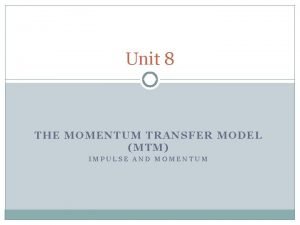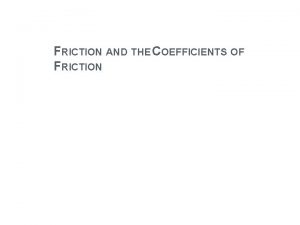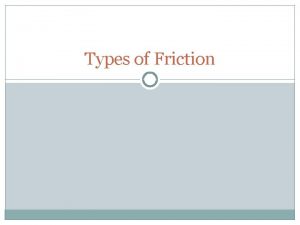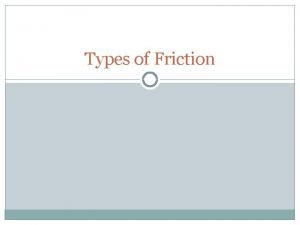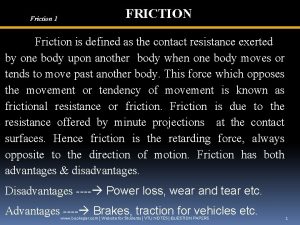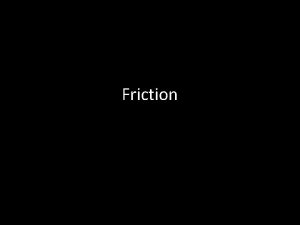Section 5 8 Friction Friction Friction We must














- Slides: 14

Section 5. 8: Friction

Friction • Friction: We must account for it to be realistic! – Exists between any 2 sliding surfaces. – Two types of friction: Static (no motion) friction Kinetic (motion) friction – The size of the friction force: Depends on the microscopic details of 2 sliding surfaces. • The materials they are made of • Are the surfaces smooth or rough? • Are they wet or dry? • Etc. , etc.

• Kinetic Friction: Experiments determine the relation used to compute friction forces. • Friction force fk is proportional to the magnitude of the normal force n between 2 sliding surfaces. • DIRECTIONS of fk & n are each other!! fk n fk n a FA (applied) mg • Write relation as fk k n (magnitudes) k Coefficient of kinetic friction k depends on the surfaces & their conditions k is dimensionless & < 1

• Static Friction: Experiments are used again. • The friction force fs exists || 2 surfaces, even if there is no motion. Consider the applied force FA: n fk FA (applied) mg ∑F = ma = 0 & also v = 0 There must be a friction force fs to oppose FA FA – fs = 0 or fs = FA

• Experiments find that the maximum static friction force fs(max) is proportional to the magnitude (size) of the normal force n between the 2 surfaces. • DIRECTIONS of fk & n are each other!! fk n • Write the relation as fs(max) = sn (magnitudes) s Coefficient of static friction – Depends on the surfaces & their conditions – Dimensionless & < 1 – Always find s > k Static friction force: fs s n

Coefficients of Friction μs > μk fs(max, static) > fk(kinetic)

Static & Kinetic Friction

Fig. 5 -16, p. 119

Example n f

Example ∑F = ma n fs y direction: ∑Fy = 0; n – mg – Fy = 0 n = mg + Fy ; fs (max) = μsn x direction: ∑Fx = ma n fs y direction: ∑Fy = 0; n - mg + Fy = 0 n = mg - Fy; fs(max) = μsn x direction: ∑Fx = ma

Example n a fk a ∑F = ma For EACH mass separately! x & y components plus fk = μkn

Example 5. 11 Place a block, mass m, on an inclined plane with static friction coefficient μs. Increase incline angle θ until the block just starts to slide. Calculate the critical angle θc at which the sliding starts. Solution: Newton’s 2 nd Law (static) y direction: ∑Fy = 0 n – mg cosθ = 0; n = mg cosθ x direction: ∑Fx = 0 mg sinθ – fs = 0; fs= mg sinθ Also: fs = μ s n Put (1) into (3): fs = μsn mg cosθ Equate (2) & (4) & solve for μs = tanθc (1) (2) (3) (4)

Example 5. 12

Example 5. 13
 I must become less
I must become less Jill is climbing. where does she need high friction
Jill is climbing. where does she need high friction Sectional view examples
Sectional view examples Revolved section drawing
Revolved section drawing Section view
Section view Chemical potential energy images
Chemical potential energy images Concept mapping chapter 10 meiosis 1 and meiosis 2
Concept mapping chapter 10 meiosis 1 and meiosis 2 An effective paragraph must
An effective paragraph must Come not because you must
Come not because you must According to wentling (1980), evaluation must do more than
According to wentling (1980), evaluation must do more than When fighting fires a firefighter must use great caution
When fighting fires a firefighter must use great caution Timestamps must have following properties namely
Timestamps must have following properties namely Regulated medical waste falls into which dot hazard class
Regulated medical waste falls into which dot hazard class Claims of values examples
Claims of values examples Must mustn t
Must mustn t










